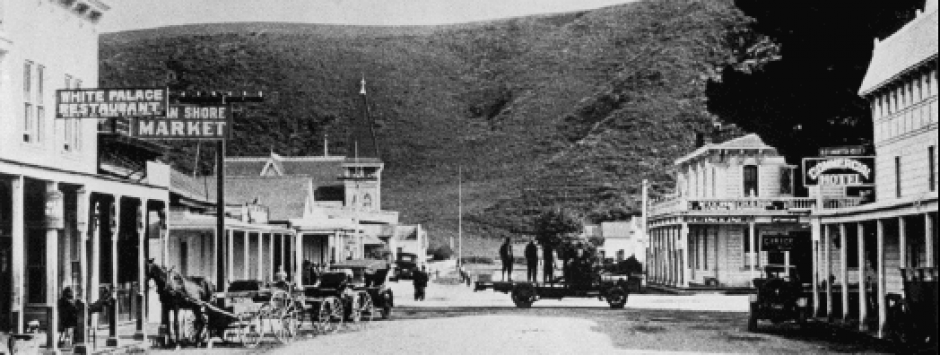Story by June Morrall
In the mid-to-late 19th century, San Francisco’s great need for wood for building new structures– as well as replacing old ones that fed the frequent fires– led to the construction of profitable sawmills south of Half Moon Bay.
(At least in one case, ownership of the Rufus Hatch Mill, led to local political power in the 20th century when son Alvin Hatch went on to become a San Mateo County supervisor.)
But the Hatch Mill was located close to Half Moon Bay, with the pier and warehouse at Amesport (Miramar Beach), probably shipping Hatch’s timber to the City.
Pigeon Point Landing, south of Pescadero, was the shipping headquarters for the sawmills located on the South Coast. Redwoods and pine trees stood tall near the Pescadero, Butano and Gazo creeks.
[In the 1870s the Gazos flume did an outstanding business. During less than 5 hours, 25,000-feet of lumber floated through the flume.]
Lumber operators set up deep inside the forests, felled the trees, and processed them into shingles and railroad ties. Logging was an extremely dangerous profession, naturally attracting fearless men who loved danger. For the investor, it was an expensive proposition, due to the added cost of physical labor and mules moving the heavy logs and finished wood through the roadless redwoods to isolated Pigeon Point.
[In other cases, “flumes,” were used to float the wood from one place to another.]
The dream was to build a small railroad that would ferry the wood and shingles between the wharf and the sawmills. Better yet move the sawmills next door to Pigeon Point.
On the other hand, the difficulty that the logistics presented left many of the trees untouched–including a large stand of redwoods along Pescadero Creek (said to be the largest such stand south of Mendocino.)
Millions of board feet of lumber were also left along the Butano and Gazo creeks, untouched well in the 1900s.
Clarence Hayward was a big name in the lumber business. Hayward’s lumber, shingle and grist mills were located three miles east of the flag pole on San Gregorio Street in Pescadero. Clarence, who lived in an old house with beautiful gardens near the mill, sold pine and redwood and sometimes bartered for grain.
William Waddell was a pioneer sawmill owner who came to the South Coast from Kentucky in 1851. A good storyteller, Waddell said the abundant timber lining the banks of Pescadero creek was “unknown to the woodman’s axe” when he arrived.
William Waddell became the stuff of legend when a grizzly bear killed him in 1875. As a tribute to the sawmill owner [whose operations stood on both sides of the San Mateo-Santa Cruz County boundary line Waddell creek was named in William Waddell’s honor.
